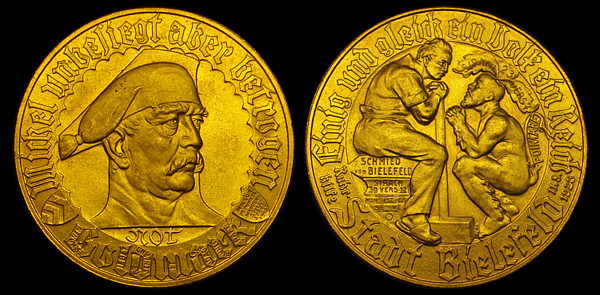
STADT BIELEFELD (GERMAN) GOLDMARK 1923
L- 40.5 City Savings Bank of Bielefeld (Westfalen) Gilded Bronze 1 Mark Coin / Post WW I Propaganda / Stab-in-the-Back / Occupation of the Ruhr.
This coin was issued in 1923 by the city savings bank of the German city of Bielefeld. This outstanding coin exhibits some of the highest levels of craftsmanship and design to be found on notgeld. It is also a wonderful and poignant example of post war propaganda illustrating many of the underlying reasons for continued discontent in Germany after what was seen as a humiliating defeat in World War I.
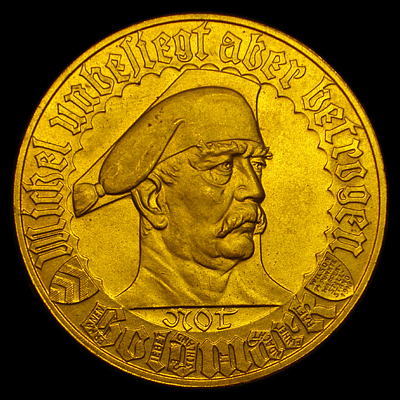 |
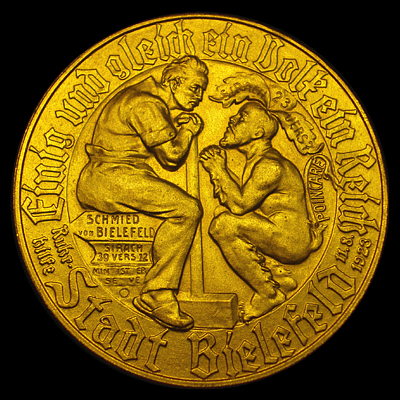 |
| Obverse: "Michel unbesiegt aber betrogen" (Michel, undefeated but betrayed) / this inscription is repeating what is known as the 'stab-in-the-back' legend, in German it is called the Dolchstoß-Legende. Depicted is a bust right resembling Otto von Bismarck as 'Michel' wearing a sleeping cap inside the one denomination. | Reverse: "Stadt Bielefeld" (City of Bielefeld) / "Einig und gleich, ein Volk, ein Reich" (United and equal, one people, one empire) Depicted as kneeling devil is President Raymond Poincaré of France whose name is around the tail. Above his head is a verse from the biblical ethical teachings of Ben Sira: "SIRACH 23 VERS 7" (Hear, O ye children, the discipline of the mouth: he that keepeth it shall never be taken in his lips.) The second figure is a Blacksmith leaning on a large hammer and sitting on signs reading: |
 |
Below is the word "not" (emergency) above the word "GOLDMARK" (currency of the German Empire from 1873 to 1914), The letters of GOLDMARK are used as initials of "GERMANEN LIEBET DEUTSCHLAND MIT ANDACHT REINHEIT KRAFT" (Germans, love Germany with devotion, purity, strength) |
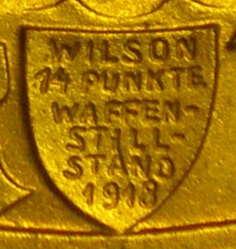 |
Shield to the right: "WILSON 14 PUNKTE WAFFENSTILLSTAND 1918" (Wilsons 14 point armistice 1918) |
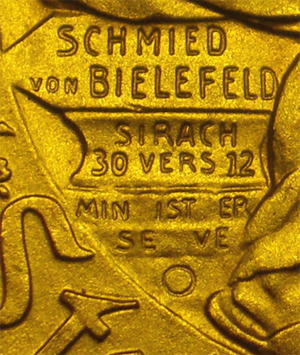 |
"SCHMIED von BIELEFELD" (Forge of Bielefeld) referring to a local tale about a Blacksmith who makes a deal with the Devil "SIRACH 30 VERS 12" again referring to a verse in the Book of Sirach (Bow down his neck while he is young, and beat him on the sides while he is a child, lest he wax stubborn, and be disobedient unto thee, and so bring sorrow to thine heart.) "MINISTER SEVE" (Minister Carl Wilhelm Severing, a politician during the empire and Weimar Republic) "11.8.1923" (refers to the day when Germany interrupted the reparation payments due to the French-Belgian occupation of the Ruhr area.) "Ruhrhilfe" (Ruhr Assistance) |
This coin makes a direct reference to President Woodrow Wilson and his 14 point armistice. Germany accepted the moderate terms laid down by Wilson assuming these terms would be the basis for a later treaty. They signed an armistice on Nov. 11, 1918. The resulting Treaty of Versailles went far beyond the moderate proposals of the Fourteen Points and left a legacy of bitterness, resentment, and recrimination among the Germans.
The situation was grim. Soldiers were defeated and felt betrayed by their government as they were forced to give up a fight many believed they could still win. They blamed a populous whom they felt had not supported the war sufficiently. In reality the people at home had greatly suffered for the war. Worker strikes had hampered efforts though such strikes were the direct result of a faltering economy and severe shortages of even the most basic needs for survival. Life in Germany at this time had, for most, become a day to day struggle to survive.
Wilson's 14 points:
- No secret diplomacy
- Freedom of Navigation on the Seas
- No international barriers to trade and equality of trade
- Reduction of national armament
- Impartial adjustment of colonial claims and disputes
- Evacuation of Russian territory with self-determination
- Evacuation and restoration of Belgian sovereignty
- Restoration of French sovereignty
- Adjustment of the Italian frontiers
- Autonomy for the population of Austria- Hungary
- Evacuation and restoration of the Balkan nations and peoples
- The internationalization of the Dardanelles
- Independence for Poland with guaranteed access to the sea
- The creation of a League of Nations
The Treaty of Versailles covered all this and more. Germany lost all its colonies and many of its European holdings and their army could be no larger than 100,000 men. This force was virtually powerless as Germany could not manufacture, import, or export weapons. Tanks, submarines, military aircraft, and artillery were all banned.
Germany was forced to take full responsibility for the war, as such they were forced to pay reparations to the tune of hundreds of billions of marks. Said reparations would be paid in gold and natural resources. The German Empire would be dismantled, a republic would replace it (Weimar) and the Emperor Wilhelm II would be tried as a war criminal.
The inscription "Michel unbesiegt aber betrogen" (Michel, undefeated but betrayed) is referring to the Dolchstoßlegende (Dagger stab legend). This is the popularly held belief that the reasons for the German defeat in World War I was betrayal and sabotage through insufficient support by the government, politicians, the workers, industrial concerns, war profiteers, Jews and Communists.
It stemmed from the idea that German forces were not defeated on the battlefield but on the home front. It was believed that German forces were still willing and able to defend Germany but were betrayed by a lack of support at crucial moments. They were 'Undefeated but Betrayed".
They blamed industrialists who did not support the war enough or looked to make a profit. Certainly in any war there are profiteers but eventually industry was being expected to produce without pay, let alone profit. This led to workers not being paid, shortages, and general economic and social turmoil and unrest. They blamed the new leaders of the Weimar Republic who betrayed Germany and the troops by giving up and taking the blame for the war in exchange for positions of power. Those who would become known as the "The November Criminals". They blamed the Jews, Marxists, and Revolutionaries who had connections outside of Germany. They were thought to have plotted against the empire and sought to sabotage the war effort. Jews were accused of not having joined the war effort. Although some did openly oppose the war, many more thousands of Jews fought and died on the battlefield. In truth a large amount of the Jewish population supported the war in one way or another.
Michel refers to the personification of the average German first used in literature as far back as the 16th century. It was often used later (early 19th century) in cartoons. It is a some what ambiguous stereotype - partly sleepyhead or dope, partly "common man" who simply wants to live his life without being bothered by the government which in those days was authoritarian. You still find Michel with his night cap on in today's political cartoons. In German the word "Schlafmütze" means night cap but it can also mean sleepyhead.
In this case Michel may also refer to the code name given to the first push in a series of major offensives launched by Germany in March of 1918 called the 'Spring Offensive'. This offensive saw some of the most intense fighting of the war. German forces were initially successful in breaking through enemy lines, in many cases sending allied forces in retreat. In the end it proved fruitless, the territory was unable to be held against counterattack due in a large part to difficulty keeping the advance troops supplied.
Germany lost large amounts of veteran troops, as had the allies. German morale hit a new low when it became apparent the push had not achieved a decisive victory. After several more pushes ended with similar results, the German armies were severely depleted, exhausted and in exposed positions. Allied forces had suffered heavy losses and had lost some ground but in the end they were better supplied by fresh American troops ready to fight. They weathered the German advances and soon launched the Hundred Days Offensive which effectively ended the war.
Although there were certainly tactical mistakes made on the field. The failure of German troops to capitalize on their momentum was largely blamed on a lack of material support. Eventually this offensive would serve as proof that German forces had not been defeated by the enemy but by the inability, or worse unwillingness, of the populous to support the war effort. The failure was largely blamed on strikes in the arms industry at a critical moment of the offensive, leaving soldiers without adequate supplies. The strikes were seen to be instigated by treasonous elements, with the Jews taking much of the blame.
Whether Germany was defeated in late 1918 is debatable. They still occupied French and Belgian territory, Berlin remained 450 miles from the nearest front. Though poorly supplied, German armies were still largely in in good order with well over 4 million men still in service. No Allied army had penetrated the Western Front. Although better supplied with fresh troops from America, the French and British were war-weary and seemed unable to gather the strength to launch a full fledged invasion of Germany.
Regardless, the reality was that Germany had little choice but to capitulate. By late 1918, in the course of 3 months, most of Germanys allies had quit the war and sought terms with the Allied Forces.
In the bitter end the Dolchstoßlegende was Germanys answer to the so called 'War Guilt' clause in the Treaty of Versailles. This stated that Germany was solely responsible for the war, something not believed to be true by most Germans. Those who agreed to the Treaty were considered traitors who had 'stabbed Germany in the back' by capitulating. People like Matthias Erzberger, part of the temporary civilian government that sued for peace. He was later killed as a traitor for having signed the treaty.
The origin of the 'Stab-in-the-back' can possibly be traced back to 1918 when Ernst Müller-Meiningen, a member of the Progressive coalition in the Reich, gave a speech to exhort his listeners to keep fighting:
As long as the front holds, we damned well have the duty to hold out in the homeland. We would have to be ashamed of ourselves in front of our children and grandchildren if we attacked the battle front from the rear and gave it a dagger-stab. (wenn wir der Front in den Rücken fielen und ihr den Dolchstoss versetzten.)
Provisional President Friedrich Ebert contributed to this line of thinking when in an 1918 oration to returning troops, he stated that "no enemy has vanquished you" and "they returned undefeated from the battlefield". His purpose in saying this was purely to exalt those men who had fought so bravely for the nation and commend them for their service to the country when they were at a low point.
General Ludendorff, a chief architect of the war, gave many of these same causes for the German defeat to the British General Frederick Barton Maurice in mid 1919. Maurice is reported saying that it sounded like the German army had been stabbed in the back. Maurice denies having said anything equating to the idea.
The Weimar National Assembly initiated an investigation into the causes of the war and reasons for Germany's defeat. In late November of 1919, the highly regarded popular hero, Paul von Hindenburg, was called to testify. He quoted what General Maurice had stated, that the German army had been dagger-stabbed from behind by the civilian populace. It was the testimony of Hindenburg that led to the wide spread acceptance of the Dolchstoßlegende in post-WWI Germany.
Regardless of who said it first, this opinion was already widely held by 1923 when this coin was minted. It had become the central them in right-wing propaganda and conservative political parties during the early Weimer Republic. Those responsible for the proverbial stab were dubbed the 'November Criminals' of 1918. The 'Stab-in-the-back' and the 'November Criminals' would be a major rallying point in the Rise of Adolf Hitler and the Nazi Party in the years to come.
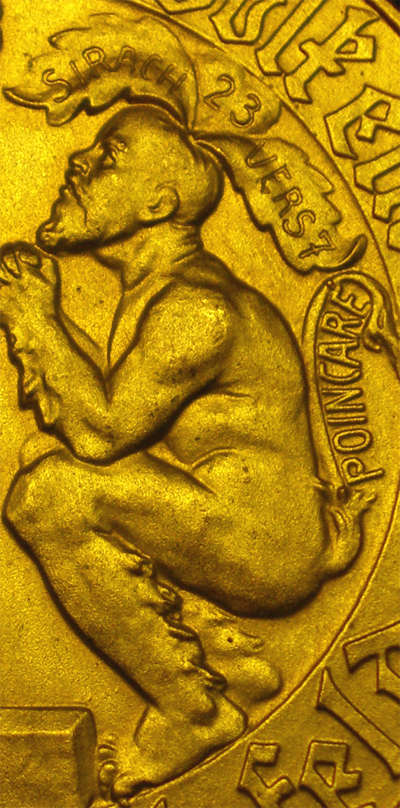 |
The scene on the reverse illustrates a local tale about a blacksmith from Bielefeld co-opted for political satire and propaganda using the French President Raymond Poincaré as the Devil. |
By the time this coin was minted, Germany had suspended reparation payments because of a failing economy. In order to pay off the state's debts, the government under Wilhelm Cuno printed off vast amounts of money leading to hyperinflation which peaked in the summer of 1923. Blame for this would be placed on reparations but the larger fault rested on the governments flawed monetary policies.
French and Belgian forces occupied the German Ruhr Area in order to take advantage of that areas industry and rich natural resources. This was met with a largely passive resistance from government, business, and the populace. Coal miners and railway workers refused to obey any instructions by the occupation forces. Production and transportation came to a standstill, this led to further economic woes and passive resistance was called off in late 1923. The French, with their own economic problems, eventually accepted the Dawes Plan and withdrew from the occupied areas in 1925.
The reverse of this coin makes mention of SCHMIED von BIELEFELD or the Smith of Bielefeld) referring to a local tale about a Blacksmith who makes a deal with the Devil. The story is as follows:
Once upon a time there was a smith in Bielefeld who knew his art like nobody else. In order to become even better and learn all secret arts, he made a pact with the devil. He then became so famous that even St. Peter - who one time had to go down and whose horse had a loose horseshoe - went to him. Asked how much he (Peter) owed, the smith said he did not want any money; however, he said he had a bag that would always lose some money, and asked the apostle to bless the bag. That is what Peter did.
Some time later the time of the pact with the devil came to its end, and the devil came to get the smith. He knocked at the door, but the smith said he could simply come in through the keyhole. The devil did that but got caught in the bag that the smith held against the keyhole. Then the smith closed the bag, took it to his anvil and hammered until the devil was willing to give up (ie. to not take the smith with him).
When the smith felt he was about to die, he had his fur apron put on, and when he was dead, went to the heaven's gate. But peter refused to let him in, due to the former pact with the devil. The he went to hell, but the devil would not let him in because the smith had beaten him so hard. So the smith went back to heaven and, when Peter opened the gate to let a pious virgin in, he threw his apron in. Peter would not allow that and told the smith to take it out again. However, once inside, the smith sat down on his apron fur and refused to leave. Peter, who remembered that the smith had voluntarily given to the poor, would finally let him stay - where the smith is still sitting today. -- this story in German
The coin depicts the French President Raymond Poincaré as the Devil and Minister Carl Wilhelm Severing as the Blacksmith. Poincaré was one of the driving forces behind the French-Belgian occupation of the Ruhr area, and Severing supported the opposition against it while at the same time being loyal to the German government. Severing was a locksmith before serving in public office, so in a way he was the "Smith of Bielefeld" of his time.
This coin conveys a message of defiance in the face of humiliation and betrayal. It also harkens back to better days under the prosperous German Empire calling for German unity with the inscriptions "United and equal, one people, one empire" and "Germans, love Germany with devotion, purity, strength".
Carl Wilhelm Severing was a popular politician under the empire as well as the new republic. He was a social democrat who was from Herford, near Bielefeld. Originally a locksmith by trade, by the time this coin was minted he was the Interior Minister of Prussia. He is best known for his role in authorizing the rearmament of Germany. His stated reason was the need for more forces to defend against possible attacks and to preserve the peace in the face of widespread social upheaval.
Bielefeld is a city of roughly 325,000 people in North Rhine-Westphalia, on both the western and eastern slopes of the Teutoburg Forest. Bielefeld is an urban district meaning it is one of the 116 cities that represent a district in their own right.
After its founding in 1214 by Count Hermann IV, the town grew into a fortified city known for producing fine linen. Administration of the city changed hands many times through the years until the Kingdom of Prussia gained possession of it after the conclusion of the Napoleonic Wars in the early 19th century. The railroad reached Bielefeld in the mid 19th century, with it came industrialization in the form of mills and metal works and a steady rise in population.
By World War I, Bielefeld had entered the war as a part of the German Empire. Bielefeld was an important industrial base helping to supply the German war effort. In the end, the city was not spared the attrition and economic turmoil that plagued Germany during and after the war.
After the war Bielefeld became one of the more prolific producers of notgeld. Often referred to as the 'City of Linen', Bielefeld issued an extensive and popular series of high denomination notes printed on silk, linen, and velvet during post war and hyperinflation. They also minted a variety of coins, some with strong political themes. Many thanks to Christian from www.cointalk.org for his help with translation.
